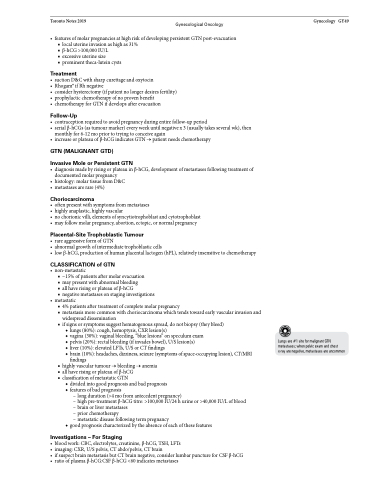Page 535 - TNFlipTest
P. 535
Toronto Notes 2019 Gynecological Oncology Gynecology GY49
• featuresofmolarpregnanciesathighriskofdevelopingpersistentGTNpost-evacuation ■ local uterine invasion as high as 31%
■ β-hCG>100,000IU/L
■ excessive uterine size
■ prominent theca-lutein cysts
Treatment
• suctionD&Cwithsharpcurettageandoxytocin
• Rhogam®ifRhnegative
• considerhysterectomy(ifpatientnolongerdesiresfertility) • prophylacticchemotherapyofnoprovenbenefit
• chemotherapyforGTNifdevelopsafterevacuation
Follow-Up
• contraceptionrequiredtoavoidpregnancyduringentirefollow-upperiod
• serialβ-hCGs(astumourmarker)everyweekuntilnegativex3(usuallytakesseveralwk),then
monthly for 6-12 mo prior to trying to conceive again
• increaseorplateauofβ-hCGindicatesGTN→patientneedschemotherapy
GTN (MALIGNANT GTD)
Invasive Mole or Persistent GTN
• diagnosismadebyrisingorplateauinβ-hCG,developmentofmetastasesfollowingtreatmentof documented molar pregnancy
• histology:molartissuefromD&C
• metastasesarerare(4%)
Choriocarcinoma
• oftenpresentwithsymptomsfrommetastases
• highlyanaplastic,highlyvascular
• nochorionicvilli,elementsofsyncytiotrophoblastandcytotrophoblast • mayfollowmolarpregnancy,abortion,ectopic,ornormalpregnancy
Placental-Site Trophoblastic Tumour
• rareaggressiveformofGTN
• abnormalgrowthofintermediatetrophoblasticcells
• lowβ-hCG,productionofhumanplacentallactogen(hPL),relativelyinsensitivetochemotherapy
CLASSIFICATION of GTN
• non-metastatic
■ ~15% of patients after molar evacuation
■ may present with abnormal bleeding
■ all have rising or plateau of β-hCG
■ negative metastases on staging investigations
• metastatic
■ 4% patients after treatment of complete molar pregnancy
■ metastasis more common with choriocarcinoma which tends toward early vascular invasion and
widespread dissemination
■ if signs or symptoms suggest hematogenous spread, do not biopsy (they bleed)
◆ lungs (80%): cough, hemoptysis, CXR lesion(s)
◆ vagina (30%): vaginal bleeding, “blue lesions” on speculum exam
◆ pelvis (20%): rectal bleeding (if invades bowel), U/S lesion(s)
◆ liver (10%): elevated LFTs, U/S or CT findings
◆ brain (10%): headaches, dizziness, seizure (symptoms of space-occupying lesion), CT/MRI
findings
■ highlyvasculartumour→bleeding→anemia
■ all have rising or plateau of β-hCG
■ classification of metastatic GTN
◆ divided into good prognosis and bad prognosis ◆ features of bad prognosis
– long duration (>4 mo from antecedent pregnancy)
– high pre-treatment β-hCG titre: >100,000 IU/24 h urine or >40,000 IU/L of blood – brain or liver metastases
– prior chemotherapy
– metastatic disease following term pregnancy
◆ good prognosis characterized by the absence of each of these features
Investigations – For Staging
• bloodwork:CBC,electrolytes,creatinine,β-hCG,TSH,LFTs
• imaging:CXR,U/Spelvis,CTabdo/pelvis,CTbrain
• ifsuspectbrainmetastasisbutCTbrainnegative,considerlumbarpunctureforCSFβ-hCG • ratioofplasmaβ-hCG:CSFβ-hCG<60indicatesmetastases
Lungs are #1 site for malignant GTN metastases; when pelvic exam and chest x-ray are negative, metastases are uncommon


